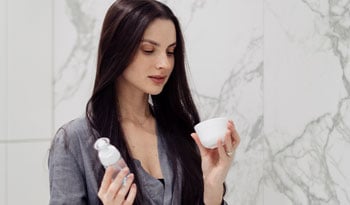Buzzworthy Skincare Ingredient: Resveratrol
DISCLAIMER:This blog does not intend to provide diagnosis...
- In this article:
- What Is Resveratrol?
- The Benefits of Resveratrol
- How Do I Take Resveratrol?
- How to Incorporate Resveratrol into Your Daily Routine

Have we found the foundation of youth? Potentially. You may have heard about resveratrol, which is all the rage lately in both food and skincare. You’re probably wondering what it is and whether it lives up to the hype. Let’s take a look.
What Is Resveratrol?
Resveratrol is a naturally occurring polyphenolic molecule found in fermented grapes and more than 70 plant species. In nature, resveratrol works to protect plants from ultraviolet radiation, infections, and other external or environmental stressors. In laboratory studies, it has been shown to increase the lifespan of animals.
Resveratrol belongs to a group of antioxidant compounds called polyphenols, which boast lots of health benefits. Polyphenols have anti-inflammatory, antimicrobial and photoprotective properties. There are even studies showing that polyphenols may protect against diseases such as diabetes, atherosclerosis, dementia, and osteoporosis.
Polyphenols and many other antioxidants work by scavenging up free radicals that would otherwise damage our cellular DNA. Our bodies are constantly producing free radicals generated by the sun, the environment, and even through the process of digesting food. Free radicals are an undesired but essential part of cellular function.
Some common antioxidants you are most likely familiar with include vitamin C and E. But polyphenols are another class of strong antioxidants. They are found in red wine, dark chocolate, berries, and tea, just to name a few sources.
Resveratrol in particular has been gaining popularity, and it’s been coined the “longevity molecule.” Let’s explore the benefits of this antioxidant and how you can best incorporate it into your lifestyle and skincare.
The Benefits of Resveratrol
Resveratrol is a non-flavonoid polyphenol, and can also be found under the chemical name stilbene. It has been shown to have both anti-aging and medicinal benefits due to its anti-inflammatory nature. Inflammation, we know, plays a huge role not only in aging, but also in disease processes.
Resveratrol helps with anti-aging by modulating a group of proteins that regulates cell metabolism and DNA repair. It also inhibits enzymes in the body that break down collagen, a process that leads to signs of aging like fine lines and wrinkles.
How Do I Take Resveratrol?
Resveratrol can be ingested orally either from food or dietary supplements. The most well-known food source is grape skin and red wine. Other sources include berries, nuts, and cacao. However, the bioavailability from food sources is limited. Although we can effectively absorb this compound through our GI system, it gets quickly metabolized to other byproducts, and it’s hard to assess how much active compound is available. Even at larger doses, only trace amounts of the active molecule are found in the bloodstream. This makes scientific studies challenging to conduct, and we currently don’t know how beneficial oral resveratrol is, how much is needed for the antioxidant effect, and if the byproducts have any potential benefit.
Since the oral route may not be the most effective way to consume resveratrol, incorporating it into your skincare routine makes the most sense.
Studies have shown that when topical resveratrol is applied to skin, it effectively absorbs and is still able to have an antioxidant effect. In hydrogen form, it has been shown to improve skin texture, diminish the appearance of fine lines and wrinkles, and even out skin tone. Resveratrol also has antibacterial and antifungal properties, and limited studies have suggested it may even help to reduce inflammatory acne with minimal irritation or dryness.
Topical resveratrol also has skin brightening effects. Studies have demonstrated that it can help to decrease hyperpigmentation from acne, sun damage, or other external injuries to the skin. Lastly, it has been shown to help reduce redness on the skin, and may be a great topical treatment for those plagued by rosacea or frequent facial flushing. In a small group study, individuals using topical resveratrol and green tea reported reduction in facial redness by just six weeks of use.
How to Incorporate Resveratrol into Your Daily Routine
Healthy and glowing skin requires a well-balanced, nutrient-filled diet, effective skin care regimen, and good lifestyle habits. It should go unsaid that smoking, tanning, and sleep deprivation are no-nos. Although data is limited about the bioavailability of resveratrol through oral intake, I still recommend consuming it through a combination of diet and topical use.
Most of the foods containing high levels of resveratrol are good for our body and contain many other antioxidants helpful for fighting free radicals. If you are more of a pill person, I recommend supplements of 100-200mg daily, but again, the data is limited about the absorption of dietary supplements and efficacy.
For topical use, there are various formulations of resveratrol in skincare products: serums, moisturizers, creams, and even in sunscreen. Resveratrol can be found in formulation with other antioxidants such as vitamin E to improve its stability and skin penetration.
I personally love using antioxidants in serums. Serums are basically products containing super high concentrations of an active ingredient to help protect the skin, and prevent and hopefully reverse signs of aging. But unlike vitamin C serums, which should be applied in the morning to mitigate sun damage, resveratrol should be applied at night to give our skin what it needs to repair itself from all the environmental and internal damage from the day.
Lastly, remember that stability and penetration are key when looking for the right product. Like vitamin C products, resveratrol products can be degraded by ultraviolet radiation. Make sure that your product is in an opaque bottle that’s airtight to maximize its potency.

 By Dr. Jenny Liu, M.D.
By Dr. Jenny Liu, M.D.


